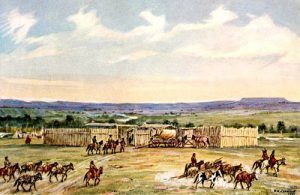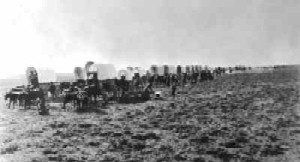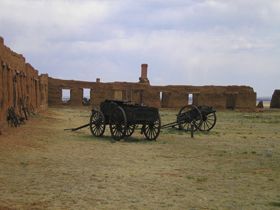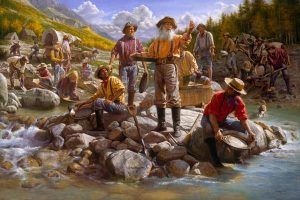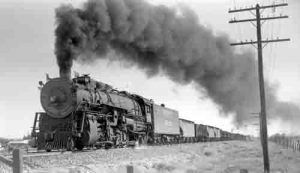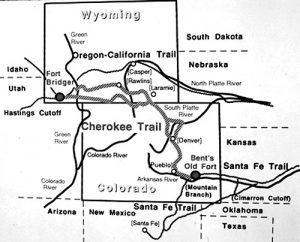
Cherokee Trail Map, courtesy Playground Trail
The Cherokee Trail was a historic overland trail through Oklahoma, Kansas, Colorado, Wyoming, and Montana used from the late 1840s up through the early 1890s.
The trail route ran from the Grand River near present-day Salina, Oklahoma, northwest to strike the Santa Fe Trail at McPherson, Kansas. From there, it followed the Santa Fe Trail west, then turned north along the base of the Front Range of the Rocky Mountains in Colorado, over the old Trapper’s Trail, to the Arkansas/Platte River divide, and descended along Cherry Creek into the South Platte River.
In Colorado, the original 1849 trail followed the east side of the South Platte River to present-day Greeley, then west via a wagon road to Laporte in Laramier County. The wagon road was built from Laporte north past present-day Virginia Dale Stage Station to the Laramie Plains in southeastern Wyoming.
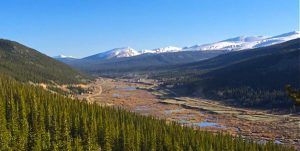
South Platte River Valley in Colorado courtesy the Colorado Independent
The trail then proceeded to the northwest around the Medicine Bow Range, crossing the North Platte River before turning north to present-day Rawlins, Wyoming. From there, the trail meandered west before finally joining the Oregon, California, and Mormon Trails near modern-day Farson and Fort Bridger, Wyoming.
Hearing of the discoveries of gold in California, many of the Cherokee Indians were enticed to the goldfields to seek their fortunes. According to the Cherokee Advocate’s March 19, 1849 edition, “men who were worth only a few dollars are worth thousands within a few months of their arrival to California.” The rumors and dreams of gold prompted one Cherokee named Lorenzo Delano to sell his land to travel to California. The sale of his property was listed in the Cherokee Advocate. He was not alone in selling everything he owned on the Cherokee Reservation and heading west.
The route was established in 1849 by a wagon train headed to the California goldfields. Among the expedition members was a group of Cherokee Indians, hence the name of the trail. The wagon train was comprised of a group of white settlers from Washington County, Arkansas, and several Indians from the Cherokee Nation. The emigrants left Arkansas on April 24, 1849. Once they arrived in Tahlequah, Oklahoma, and were joined by several Cherokee Indians, they gathered to establish rules and elect a leader. Lewis Evans, a former sheriff of Evansville, Arkansas, was elected Captain, so this expedition is often written as the “Evans/Cherokee” Train. The company called itself the “Washington County Gold Mining Company,” which consisted of 130 people and 40 wagons.
They were the first wagons over explorer John C. Fremont’s Trail in the area and were using his journals. The wagon train followed a trail along the Front Range of Colorado, then turned west along the Colorado/Wyoming Border toward Fort Davy Crocket. At this point, they stopped following Fremont’s directions and blazed the Northern Cherokee Trail south of Elk Mountain in Wyoming and then across the Red Desert to Fort Bridger.
Not everyone in the Cherokee Nation viewed the gold rush with the same enthusiasm. By the late spring of 1850, many leaders in the Cherokee Tribe became alarmed at the large numbers of men and even women leaving for the goldfields. An article written on March 19, 1849, describes California as a land without law or government in the Cherokee Advocate. On June 10, 1850, this was followed weeks later by an article published by the Cherokee Advocate warning about the gold fever. The paper lamented the loss of tribal members taken from their homes by the lure of fame and fortune. The editor wrote: “In this universal rising his majesty tul-lo-ni-ca [Cherokee for yellow] has driven numerous Cherokees into the chase, and it is to them too gold for riches at once, and through the journey of life repose in golden dreams.”
Despite the warnings, the year 1850 marked the beginning of the continuous use of the Cherokee Trail by gold seekers, emigrants, and cattle drovers from Arkansas, Texas, Missouri, and the Cherokee Nation.
Further use of the trail was made by travelers who wanted to avoid the cholera epidemic, which ravaged the travelers following main trails.
That year, four separate wagon trains of white settlers and Cherokee Indians would make the trek along the Cherokee Trail. In one of those wagon trains was a Cherokee man named John Lowery Brown who kept a diary of their journey. The wagon train left Salina, Oklahoma, on about May 22nd.
Several days later, they came to the Santa Fe Trail and turned west along the Arkansas River. Passing the remains of Bent’s Fort in Colorado, the train continued west to Pueblo, where they traveled north along the east range of the Rocky Mountains. Near present-day Denver, the group took a more direct route than did the Evans party of the prior year, who had continued northerly along the east bank of the South Platte River.
This group took a more direct route which crossed the Platte River and headed northwest. On June 21st, they stopped at the confluence of two unnamed streams to rest. The next morning, a train member named Lewis Ralston was gold panning in the stream when he shouted “Gold!”
Ralston was an Irishman whose wife, Elizabeth Kell, had Cherokee ancestry. Ralston and his brother-in-law, Samuel Simons, had left Georgia in early 1850, hoping to gain wealth in the west. When they arrived in northeastern Indian Territory, they joined the Cherokee wagon train headed for the goldfields.
After Ralston announced his gold find, he was quickly joined by several other train members, but only a few flakes could be found. In the end, they concluded that the California gold would be richer.
Brown, in his journal, wrote: “June 22 Lay Bye. Found Gold” and in the margin of the leather-bound book he noted, “We call this Ralstons Creek because a man of that name found gold here.”
The emigrant party then proceeded north to Laporte and onto the Laramie Plains, where they turned west along the Colorado/Wyoming border via the Fort Davy Crockett Trail to Fort Bridger. The lead wagon company blazed the road from Tie Siding to Fort Bridger. The changed route then became known as the Southern Cherokee Trail. The wagon train completed its journey, arriving in California on September 28, 1850.
Both the northern and southern routes of the Cherokee Trail were heavily used, but neither went over Bridger Pass, as it was not open for wagons or used by the military until 1858. At that time, most wagon trains utilized a variation of the Evans 1849 trail, including Bridger Pass.
In addition to gold seekers making their way to California, several military commands also followed the Cherokee Trail. Captain Randolph B. Marcy used it as a return route after he journeyed through Colorado’s mountains from Fort Bridger to Fort Union, New Mexico, in the winter of 1857-58.
Eight years after he had made his trip to the California Goldfields, Lewis Ralston, of the 1850 Cherokee Trail party, returned to “Ralston’s Creek” with Green Russell. Members of this party founded Auraria, which was later absorbed into Denver City in 1858 and touched off the 1859 Colorado Gold Rush. The confluence of Clear Creek and Ralston Creek, the site of Colorado’s first gold discovery, is now in Arvada, Colorado.
In the 1860s, portions of the trail from northern Colorado to Fort Bridger in Wyoming were incorporated as part of the Overland Trail and stage route between Kansas and Salt Lake City, Utah. At this time, it was called the Cherokee/Overland Trail.
During the Civil War, the Cherokee Trail was the recommended route between Denver and the Montana goldfields. The Rocky Mountain News told travelers to take the Cherokee Trail from Denver north and then follow the route west to Fort Bridger. There, travelers were advised to head north to Fort Hall, Idaho, then travel the remaining 200 miles to the mines.
The outlaw L.H. Musgrove traveled on the Cherokee Trail from Colorado into Wyoming during the 1860s.
By 1868 the Union Pacific Railroad had laid its track all the way across southern Wyoming. With this railroad completed, the emigrant trails began to lose their significance, and freight roads emerged to serve areas south and north of the railroad. By 1868 the only roads remaining in northwestern Colorado led to Wyoming.
Today, wagon ruts, swales, and cut-down ravines and river banks can be followed. today, in some segments and sites, from Fort Gibson/Tahlequah, Oklahoma, through Kansas, Colorado, and Wyoming to Fort Bridger, Wyoming.
In Colorado, parts of the trail are still visible and walkable in Arapahoe, Douglas, and Larimer counties. An approximation of the route can be driven on State Highway 83 from Parker near Denver to Colorado Springs.
Other parts of the old trail can be seen on the Bureau of Land Management land in Wyoming. In Sweetwater County, the trail is marked with four-foot-high concrete posts.
© Kathy Weiser-Alexander/Legends of America, updated April 2021
Also See:
The California Trail – Rush to Gold
Oregon Trail – Pathway to the West
Tales & Trails of the American Frontier
Sources:
Cherokee Trail
Historic Douglas County
Oregon-California Trail Association
Overland Trail
Western Wyoming Community College
Were you looking for The Cherokee Trail of Tears?

